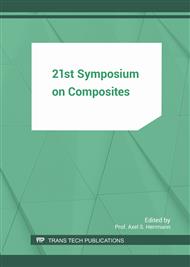p.621
p.629
p.636
p.644
p.652
p.660
p.666
p.673
p.681
Measurements of Mode I Interlaminar Properties of Carbon Fiber Reinforced Polymers Using Digital Image Correlation
Abstract:
Numerical models based on cohesive zones are usually used to model and simulate the mechanical behavior of laminated carbon fiber reinforced polymers (CFRP) in automotive and aerospace applications and require different interlaminar properties. The current work focuses on determining the interlaminar fracture toughness (GIC) under Mode I loading of a double cantilever beam (DCB) specimen of unidirectional CFRP, serving as prototypical material. The novelty of this investigation is the improvement of the testing methodology by introducing digital image correlation (DIC) as an extensometer and this tool allows for crack growth measurement, phenomenological visualization and quantification of various material responses to Mode I loading. Multiple methodologies from different international standards and other common techniques are compared for the determination of the evolution of GIC as crack resistance curves (R-curves). The primarily metrological sources of uncertainty, in contrast to material specific related uncertainties, are discussed through a simple sensitivity analysis. Additionally, the current work offers a detailed insight into the constraints and assumptions to allow exploration of different methods for the determination of material properties using the DIC measured data. The main aim is an improvement of the measurement technique and an increase in the reliability of measured data during static testing, in advance of future rate dependent testing for crashworthiness simulations.
Info:
Periodical:
Pages:
652-659
Citation:
Online since:
July 2017
Authors:
Price:
Сopyright:
© 2017 Trans Tech Publications Ltd. All Rights Reserved
Share:
Citation:


